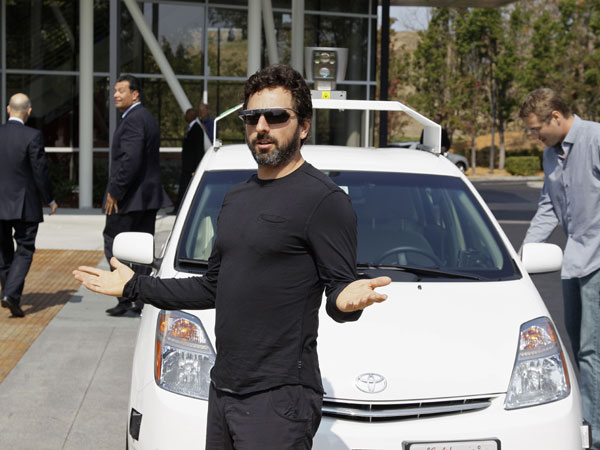Google: Driverless cars are mastering city streets

In this Sept. 25, 2012, file photo, Google co-founder Sergey Brin gestures after riding in a driverless car with officials, to a bill signing for driverless cars at Google headquarters in Mountain View, Calif. Google engineers say they have turned a corner in their pursuit of creating a car that can drive itself. AP
LOS ANGELES, CALIFORNIA— Google says that cars it is programming to drive themselves have started to master the navigation of city streets and the challenges they bring, from jaywalkers to weaving bicyclists — a critical milestone for any commercially available self-driving car technology.
Despite the progress over the past year, the cars have plenty of learning to do before 2017, when the Silicon Valley tech giant hopes to get “autonomous driving” technology to the public.
None of the traditional automakers has been so bullish. Instead, they have rolled out features incrementally, including technology that brakes and accelerates in stop-and-go traffic, or keeps cars in their lanes.
“I think the Google technology is great stuff. But I just don’t see a quick pathway to the market,” said David Alexander, a senior analyst with Navigant Research who specializes in autonomous vehicles.
His projection is that self-driving cars will not be commercially available until 2025.
Google Inc.’s self-driving cars already can navigate freeways comfortably, albeit with a driver ready to take control. In a new blog post, the project’s leader said test cars now can handle thousands of urban situations that would have stumped them a year or two ago.
“We’re growing more optimistic that we’re heading toward an achievable goal — a vehicle that operates fully without human intervention,” project director Chris Urmson wrote. The benefits would include fewer accidents, since in principle machines can drive more safely than people.
Urmson’s post was the first official update since 2012 on a project that is part of the company’s secretive Google X lab.
In initial iterations, human drivers would be expected to take control if the computer fails. The promise is that, eventually, there would be no need for a driver. Passengers could read, daydream, even sleep — or work — while the car drives.
That day is still years away, cautioned Navigant’s Alexander.
He noted that Google’s retrofitted Lexus RX450H SUVs have a small tower on the roof that uses lasers to map the surrounding area. Automakers want to hide that technology in a car’s existing shape, he said. And even once cars are better than humans at driving; it will still take several years to get the technology from development to large-scale production.
Google has not said how it plans to market the technology. Options include collaborating with major carmakers or giving away the software, as the company did with its Android operating system.
While Google has the balance sheet to invest in making cars, that is unlikely. Certainly not in the 2017 time-frame that Google co-founder Sergey Brin has laid out.
Urmson said in an interview that 2017 is “a pretty great time frame” for people living near Google’s San Francisco Bay Area headquarters to expect to have access to the technology, but in what form remains to be seen.
While Brin is his boss, and he wants to keep the boss happy, Urmson said safety will come first.
He added that he has another milestone in mind: His 10-year-old son can get behind the wheel in about five years, and knowing how teens drive, he’d like to see the technology available by 2019.
For now, Google is focused on the predictably common challenges of city driving.
To deal with cyclists, engineers have taught the software to predict likely behavior based on thousands of real-life encounters, according to Google spokeswoman Courtney Hohne. The software plots the car’s path accordingly — then reacts if something unexpected happens.
Before recent breakthroughs, Google had contemplated mapping all the world’s stop signs. Now the technology can read stop signs, including those held in the hands of school crossing guards, Hohne said.
While the car knows to stop, to start it again is still a challenge, partly because the cars are programmed to drive defensively. At a four-way stop, Google’s cars have been known to wait in place as other cars edge out into the intersection.
The cars still need human help with other problems. Among them, understanding the gestures that drivers give one another to signal it’s OK to merge or change lanes, turning right on red, and driving in rain or fog (which requires more sophisticated sensors).
To date, Google’s cars have gone about 700,000 miles (1.1 million kilometers) in self-driving mode, the company said. Hohne said more than 10,000 miles (16,000 kilometers) have been on city streets; Urmson said it would not be easy to calculate the total with greater specificity.
RELATED ARTICLES
California governor signs driverless cars bill
Driverless car concept gains traction at CES
Google develops contact lens glucose monitor
Driverless future sees drivers doing other things outside of driving, watching traffic














